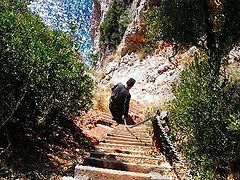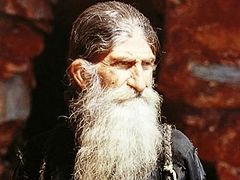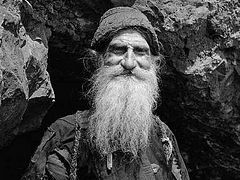Why aren’t the lampadas burning?
In around 1740, a monk of Dionysiou Monastery,1 Hierodeacon Ieremios, fell seriously ill and at the decision of the community was sent to the kathisma2 of the Holy Apostles (which was opposite the monastery), to the care of one reverend elder. The young hierodeacon’s condition worsened with each passing day, so that death was inescapable. Seeing the sick man’s state, the elder was very grieved. A few days later the sorrowing elder saw twelve men descending the mountain to him. They greeted him warm-heartedly and asked him the cause of his grief. The elder showed them the supine deacon, adding that he would most likely be saying farewell to this life very soon. But the men replied:
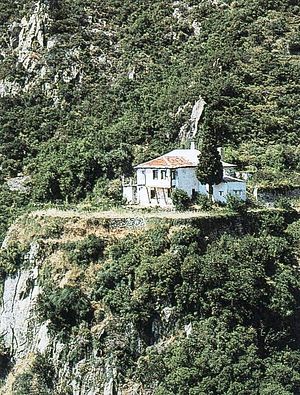 The kathisma of the Holy Apostles. “The deacon will not die. Be bold, O elder, and tell the other brothers what you saw and heard. But tell us—why didn’t you light the lampadas in the church, like you usually do? Whey aren’t they burning now?”
The kathisma of the Holy Apostles. “The deacon will not die. Be bold, O elder, and tell the other brothers what you saw and heard. But tell us—why didn’t you light the lampadas in the church, like you usually do? Whey aren’t they burning now?”
The elder started justifying himself, blaming the dochiaros,3 that he doesn’t give him any oil for the lamps.
“Tell the dochiaros not to deprive the churches of oil, or he won’t escape a sudden temptation.”
Dumfounded by the words of these unfamiliar men, the elder asked them:
“But who are you, where did you come from, and where do you live?”
The strangers replied:
“We are the masters of this kathisma!”
Having said this they went into the church, and the elder ran to the deacon to tell him about the strange pilgrims. But O, the wonder! The deacon whom he had left half-dead just a few minutes ago was sitting joyfully on the bed; his condition had sharply improved, and only a little blood dripped from his nose. Meanwhile the twelve visitors who had gone into the church disappeared! Then the elder and the deacon understood that their visitors were none other than the Twelve Apostles of the Lord! Word of the miracle spread like wildfire among the brethren of Dionysiou Monastery, and all glorified the Lord. The dochiaros who was economizing on the lamp oil was warned that his thriftiness was not pleasing to God, and the healed hierodeacon Ieremios later became the metropolitan of one of the northern dioceses in Greece.
Silver on the pistols and the monastery oars
In 1821, the Greek people’s rebellion against the Ottoman yoke broke out, which resulted in a significant part of Greece receiving independence. In their attempt to quash the Greek liberation movement, the Turks attacked various inhabited areas, including the Holy Mount Athos. Abbot Stephanos (1817–1836) of Dionysiou Monastery took the Right Hand of the Forerunner relic along with some other holy relics of the monastery and started searching for refuge in safer places, meeting a multitude of dangers and calamities along the way. In his wandering Abbot Stephanos arrived on the island of Paros, where some good Christians received him. However there were also others, who were not averse to robbing the abbot. Thus, one such man came to Fr. Stephanos and demanded a quantity of silver sufficient to cover his pistols. Should he refuse, the bandit threatened to come at night and get his revenge on the monks. The abbot found himself in a hopeless situation and gave one of the monastery’s silver lampadas, leaving judgment of the impious man up to the Honorable Forerunner. And the Baptist of the Lord was not slow to respond—a few days later the wretched man came down with dysentery and died suddenly. When he heard about the man’s pitiful end, Abbot Stephanos invited the dead man’s brother, who was a very kind man, and told him what had happened. Deeply grieved and weeping over his brother’s impious deed, that man ran to the dead man’s house, found the silver, and returned it to the abbot.
Another time the chief captain of Paros forcibly confiscated the oars of the monastery boat and sailed away to another island. Along the way an argument broke out on his vessel, which escalated into a gunfight. One bullet pierced the monastery oar and then lodged in the captain’s temple. He returned immediately to Paros, and begging forgiveness of Fr. Stephanos, returned the oar to him. The monks served two molebens for his health, blessing the waters with the Right Hand of the Forerunner, but nevertheless, the wound turned out to be fatal and the captain died.
The Forerunner’s invisible care
One of the remarkable monks of Dionysiou Monastery was Monk Vissarionos, who died in 1952. Fr. Vissarionos was adorned with humility and because of that he was vouchsafed appearances from the saints. Thus, while still a layman, he was worthy of a visit from Holy Great Martyr Parescevi, who consoled him in his sorrowful family situation and foretold that he would soon receive the monastic tonsure. As a monk, Fr. Vissarionos was twice found worthy of an appearance from Dionysiou Monastery’s patron saint, St. John the Forerunner.
The first visit from the Baptist of the Lord occurred in 1916, when Vissarionos was appointed as the steward of the monastery metochion [dependency]. Located not only outside of Mt. Athos but also in a place there was no church nearby, Fr. Vissarionos was very sad that he could not attend services, even on the great feasts. On one cold February evening, Fr. Vissiaronos went into the kitchen and saw there an old man, warming himself by the fire. He was surprised—how did the old man get into the cell? But he nevertheless cordially greeted the unexpected guest. The old man asked the monk how he was doing, and Fr. Vissiaronos did not hide his sorrow over the fact that there was no church nearby.
“What are you saying, Vissarionos!” the guest protested. “There is a church right here, on this spot! Just two steps away from the stove is where the church begins. Start digging and you’ll find it!”
The monk could not believe his ears.
“Vissiaronos, you don’t believe me, but know: It’s God’s will that you excavate the church and restore it! When you find the column of the holy Altar Table, stop, cross yourself three times with bows, and you’ll see how the earth that covers the altar table clears away by itself!”
The conversation was going on, when Fr. Vissiaronos heard a noise at the mill. He ran there to find out what was happening, and when he returned to the cell the elder was gone. Fr. Vissiaronos doubted and could not resolve to begin the work, but a week later, at night, some terrible, oppressive heaviness fell upon him and he heard a thunderous voice of warning. The frightened monk arose and in the morning began digging shown him by the Holy Forerunner, who had appeared to him in the form of an old man. It all happened as the Baptist had said: The church was unearthed and restored.
The second time the Forerunner appeared to Fr. Vissarionos, he rebuked him for his unbelief. One day a certain peasant came to the mill and after milling some flour, went into the church, venerated the icon of the Forerunner, and placed a significant amount of money before the icon as a donation. Fr. Vissarionos saw the money, but he was busy and didn’t take it yet. By evening he walked past the icon and noticed that the money was gone—someone had managed to steal it! Fr. Vissarionos was terribly upset and depressed. He turned to the icon of the Forerunner and said:
“O Holy Forerunner, aren’t you here? How did you allow the money to be stolen, right from under your icon? I’m not going to light the lamp for you today!
Frustrated and perplexed, Fr. Vissarion went to his cell. That night someone woke him up, shoving him. When he woke up, the monk saw before him a giant in garments of skin, with loose, wild hair. This was the greatest of those born of women, the Baptist of the Lord Himself! Fr. Vissarionos trembled with fear and could barely utter:
“How did you come in here?”
“Don’t ask how I came in. You had better answer why you didn’t light my lampada!”
Crying bitterly Fr. Vissarionos fell to the feet of the Forerunner and begged his foregiveness.
St. John said to him in a sweet voice:
“Vissarionos, my child! You say that I’m not here. But if I’m not here, then who has been protecting you from bandits and robbers in this deserted place? So, go and light my lampada and tell people that icons work miracles, for many here have begun to say that icons do not work miracles.”
Having said this, the Baptist became invisible. Fr. Vissarionos ran to the church and saw with amazement that the money was again lying before the icon of the Forerunner.
“Don’t I know who to appoint as head?”
A monk of Dionysiou Monastery, Monk Chrysanthos, had tried for many years to force his way into leadership positions, often beleaguering the abbot; however his many years of numerous attempts were crowned only by total failure. Fr. Chrysanthos took his bad luck very hard, and he fell into deep despair and depression, finally resolving to take his own life! “Just look,” he thought, “how many young people are being appointed to various responsibilities; but I, who have done so much for the monastery, am passed up and ignored. I won’t endure it! I’ll go down to the sea and drown myself in front of everyone. Let them see it|!”
But through the prayers of the Honorable Forerunner, the Lord suggested to the monk that before committing suicide he should close himself for three days in his cell, refuse all food and drink, and give himself over to increased prayer. This was in February 1937. The monk did just that—he shut the door and windows of his cell and in total darkness, almost without sleeping, prayed. On the third evening, his cell suddenly shone with heavenly light, and the monk heard a thunderous voice:
“Why are you so worried? Why are you disturbed and want to go down to the sea to drown yourself?”
All of Fr. Chrysanthos’s bad thoughts disappeared from the heavenly voice, and a flood of tears poured from his eyes.
“Forgive me, holy Forerunner, forgive me!...”
“Why did you abandon your singing on the cliros for a whole week now? And why are you running around here and there, asking them to appoint you head of something? Or don’t I know whom to appoint as head? How will you become a head if I don’t want you to?”
The radiance disappeared, and with it all of Fr. Chrysanthos’s sadness. He was under the particular care of the Forerunner, because he had great simplicity and sang with great love on the cliros for a whole twenty-five years!
Liturgy without a priest?
In the area of Karyes, which is the administrative center of the Holy Mount Athos, is a small church dedicated to the Holy Protomartyr and Archdeacon Stephen. On July 14, 1958, a representative from the Russian monastery of St. Panteleimon, Hieromonk Nikostrat, was invited to this church to serve a festal Liturgy. Fr. Nikostrat arrived at the church toward the end of Matins,4 but he didn’t resolve to enter the church, instead following the service with great compunction from the stasidia, which stand outside of it. When he was invited inside to begin the proskemidia, Fr. Nikostrat refused, saying:
“What am I to do inside, if you already have a priest serving?”
“A priest is serving the Liturgy inside?” the monk who had invited him said with surprise.
“How can there not be a Liturgy if the deacon only just censed all the people and icons and has already gone into the altar? Is he serving without a priest?”
The monks came to a state of compunction, because in the church there was neither priest nor deacon; the one whom the reverent Russian hieromonk had seen was the Holy Archdeacon Stephen himself! Only with great difficulty were they able to persuade Fr. Nikostrat to come into the empty altar and serve the Liturgy...
A heavenly messenger
Elder Anthimos was one of the spirit-bearing fathers of Dionysiou Monastery. At the beginning of his monastic path, Fr. Anthimos bore his obedience in the kitchen as a cook. With great love and care he prepared all possible tasty dishes for the consolation of the monastery’s brothers and pilgrims, but he himself was content to eat only dried bread and olives. Fr. Anthimos enraged the demons with this podvig, and they were ready to tear the ascetic into pieces; but God’s grace protected him, and the only thing the demons were able to do was to assemble in the kitchen and beat the pots and pans all night long, shouting and making noise. That shows how Fr. Anthimos’s fasting and prayer drove them to such lengths.
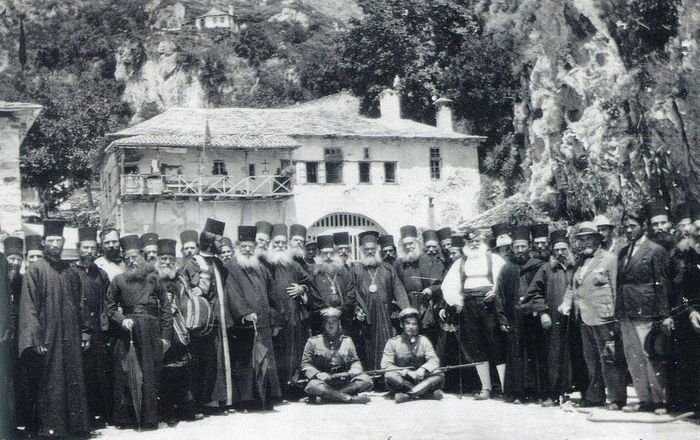 Monks and pilgrims of Dionysiou Monastery.
Monks and pilgrims of Dionysiou Monastery.
With time Fr. Anthimos received a blessing to depart from the monastery and become a desert dweller. During the first years, the anchorite had to endure many sorrows, depravations, and temptations, because he was completely alone. Thus, in the fifth year of his desert life, Fr. Anthimos fell seriously ill and could not rise from his bed. He had a high fever for three weeks straight, but he had no medicines or normal food. Regardless, the monk never ceased to glorify God for visiting him with sickness. Three weeks later the elder heard an unexpected knocking on the door of his cell.
“Through the prayers of our holy fathers...”
Fr. Anthimos arose with great difficulty and opened the door. Before him stood an unfamiliar monk, who gave him several fresh fish, saying:
“Take this fish and cook your favorite soup. If you need anything else, I am at your service; I’ll stay with you and serve you until you recover.”
Fr. Anthimos’s joy was boundless. In just a couple of days he was perfectly healthy, and the unknown monk, after bidding him farewell, became invisible. Probably he was an angel of the Lord in the visage of a monk, sent to the elder to help him in his hour of need...

